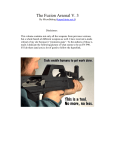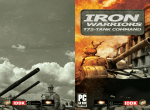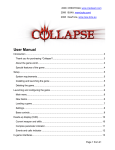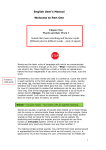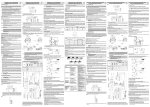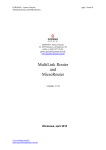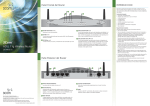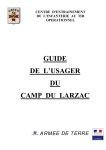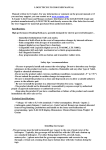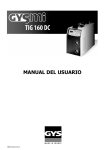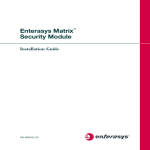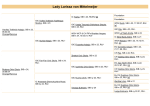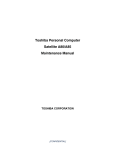Download The Fuzion Arsenal Volume I
Transcript
The Fuzion Arsenal Volume I By MicroBalrog ([email protected]) Weapons Weapon Name: TT (Tula Tokarev) Type: Handgun Year of Deployment:1930 Year of Development:1930 Main Manufacturer: USSR Old guns never die, and the TT is just one more proof of this prinicple. Modifications and clones of the weapon have been manufactured worldwide, and it is still used by hitmen in Eastern Europe and Russia and terrorists world wide. It's two only problems are that the grip is unergonomical and the absence of safety mechanism - it has been replace by a "preliminary cocking" mechanism, which often breaks. If it does, the TT can discharge when dropped and cause other such trouble. Otherwise, Tula is famous for good weaponsmiths, and they've done a good job this time too. WA +1, 2/0/0/0 Cap 8, Range 70m, Caliber 7.62*25, Weight:910 gr. Weapon Name: PM(Makarov Pistol) Type:Handgun Year of Deployment:1951 Main Manufacturer: USSR Not a very good military weapon, due to the low-powered ammo and low accuracy, but might feature as a good personal defense weapon, as it is reliable, compact, and easily concealable (use of JSP rounds is advised). The PM (or versions thereof) are still used with the army and militia. Use of PMM rounds will quickly break down the gun. Stats: WA -1, 3/0/0/0 Range - no more than 50 m Caliber- 9*18 - 8 round mag Weight: 730 gr. A bit later, the PMM (Modified Makarov Pistol) was developed, which was an improved (Not much) version of the PM Stats:WA +0, 3/0/0/0, Range - 50m? Magazine - 16 rounds Caliber - 9*18 Weight: 760 gr. Weapon Name: PSS 'Vul' Weapon Type: Handgun Year of Development:1981 Manufacturer: USSR/Russia This is a higly compact pistol, built for the special forces. No flame, no sound of fire. Uses SP-4 7.62 ammunition. WA +2, Range 40m , ROF 2/0/0/0 Cap 6 Weapon Name:MP-443 "Grach" Year of Deployment: Not yet Type:Handgun Year of Development:1990s Manufacturer: Izhevsk Mechanical Plant, Russia Description: This handgun is to be adopted by the Russian army as the 9*19mm standard issue handgun. Rumours are that some sort of special round has been developed for it. It is, however, still compatible with 9*19 mm Parabellum rounds. There is nothing special about the pistol, except that the extractor (whatever that is) is also used to indicate presence/absence of a round in the chamber. Stats: Rof 3/0/0/0, Range 100, WA +0, 17 rounds clip Weight - 1000 gr. MP-451 'Derringer' Type: Handgun Year of Development: 1990s Manufacturer:Izhevsk Mechanical Plant, Russia This small, extremely compact pistol has been developed for private use and self-defense. Although this pistol is double-barelled and has only two rounds in it (it' loaded like a miniature double-barreled shotgun), its superiority is in its extremely small size - the Derringer can be hid practically anywhere on your body. Name:MP-444 'Bagira' Type: Handgun Year of Development: 1990s Manufacturer: Izhevsk Mechanical Plant, Russia 'Bagira' is a new technological concept of the Izhevsk Plant. The people who brought to you the Kalashnikov are now coming out with a rigid-plastic pistol, just fit for the high-tech age. Versions of the weapon are available for 9*17, 9*18, and 9*19 rounds. Weight: 760 gr. Range: 100 m ROF 3/0/0/0, Cap 15 Stats: ROF 2/2/0/0, Cap 2, Range 40, Weight 400gr. Weapon Name: Gurza/Vektor SP-1 Type: Handgun Year of Deployment:1996 Year of Development:1996 Manufacturer: Russia Description: This weapon was ordered by the army, but as it lost interest, it was adopted by some special services. This extremely powerful handgun fires its own unique 9*21mm armour-piercing ammunition (9*21mm SP-1, SP-10, SP-11), good enough to punch a hole through 30 layers of Kevlar and 2.8mm of titanium at 100 meters, and designed to penetrate kevlar jackets of II-III protection levels. Stats: WA +1 Range 200m ROF 3/0/0/0, clip 18, Weight 1160 gr. (loaded) Weapon Name: APS (Stechkin Automatic Pistol) Type: Handgun Year of Deployment:1950's Year of Development:1950's Manufacturer: USSR This was originally adopted for use with the special forces. It is compact, and with an ROF of 600 rpm, can be a very cool weapon. Its standard holster is rigid and can be fitted to use as a buttstock, and this is the way it should be fired when on full-auto. If not using the buttstock you have WA -1 when firing fullauto. In the 1980-s a modification of APS, known as APSB (silenced APS) was adopted to use with external silencer and a special butt-stock (not a heavy wooden holster, but a metal butt-stock much like one used with many modern SMG's). Today it is very difficult to find an older APS with holster/butt-stock (it is heavy and hard to conceal). Stats: ROF 3/0/10/20, WA +0, Cap 20, Range 50 Caliber 9*18 Weapon Name: Kedr (Cedar) Type: SMG This submachinegun has been designed to be used by special operations forces and tankers. Cap: 20/30 Caliber: 9*18 Rof 3/0/17/30 WA +0 Range 50 Weight: 1.4 kg Weapon Name: Vikhr(Whirlwind) Year of Deployment:1990s Type: Mini-Assault Rifle(SMG) Year of Development:1990s Manufacturer: Russia Description: This is a weird weapon, a crossbreed between a rifle and an SMG, one of the first weapons in the new 9*39 caliber. As all the 9*39's, this is mainly a special ops weapon. Stats: WA +1 3/0/15/20, Damage: 8DC, cap 10/20, range 200m Weapon Name: H&K Model 54 a.k.a. MP5 Type: SMG This is perhaps one of the most famous submachineguns in the world, only rivalled by the Uzi and the Scorpion. First deployed with the Bundeswehr in 1961, this weapon, accurate like German clockwork, has spread itself to the use of armies and special ops forces all over the world. Various versions have been created, as listed below. Unless specified otherwise, the weapon caliber is 9mm parabellum. 'MP5 A2 HK-54 as described above with S-E-F trigger pack and fixed full length stock. [Trigger switched from safe to semi, to full auto, no burst-fire - MicroBalrog] MP5 A3 HK-54 as described above with S-E-F trigger pack and retractable stock. MP5 A5E HK-54 as described above with new style 4 position trigger pack allowing safe, single shot, counted burst, and full auto operation. (Short burst available, that is) MP5 SD1 HK-54, with integral sound suppressor, as described above with S-E-F trigger pack and receiver end cap (without butt stock). MP5 SD2 HK-54, with integral sound suppressor, as described above with S-E-F trigger pack and fixed full length stock. MP5 SD3 HK-54, with integral sound suppressor, as described above with S-E-F trigger pack and retractable stock. MP5 SD4 HK-54, with integral sound suppressor, as described above with counted round burst trigger pack and receiver end cap (without butt stock). [all autofire modes available - MicroBalrog] MP5 SD5 HK-54, with integral sound suppressor, as described above with counted round burst trigger pack and fixed full length stock. MP5 SD6 HK-54, with integral sound suppressor, as described above with counted round burst trigger pack and retractable stock. MP5/10 HK-54 as described above chambered in 10mm Auto. This version of the submachine gun was designed for sale to U.S. "law enforcement agencies". This version of the submachine gun is identical to the standard 9x19mm version except for the chamber specification and a different magazine. MP5/40 HK-54 as described above chambered in .40 S&W. After U.S "law enforcement agencies" determined that they had screwed up with the 10mm Auto cartridge, they decided that the .40 S&W would be better. So, this version of the submachine gun was also designed for sale to U.S. "law enforcement agencies". This version of the submachine gun is identical to the standard 9x19mm version except for the chamber specification and a different magazine. MP5/Navy The United States Navy has adopted a modified version of the MP-5. This firearm is essentially the same firearm as used by the FBI and other supposed law enforcment agencies.' From: Gil's Firearms Page Common stats: WA +1 ROF 3/3/13/40 Weight 2.55 kg Cap 15/30 Range 150 Name: Uzi Type: Submachinegun Year of Developement: 1949 Manufacturer: Israel Military Industries This world-famous submachinegun was developed by an IDF lieutenant known as Uziel Gal (hence the name). It has since been manufactured by the million, and deployed with armies all over the world including Germany and Belgiun. The Uzi is a perfect weapon for urban warfare, but breaks down easily in conditions where dirt or sand abounds. The UZI has two safety arranngements - one, the fire-rate dial, which can be set on no-fire, single shot, and extended fire (like in the MP5). Thus, setting the safety and setting the fire rate can be done in 1 action. The second safety arrangement is a button on the handle, which is pressed when the user grasps the gun firmly. If it is not pressed, the weapon cannot be fired. An Uzi has two mountings for tactical flashlights, optical sights and other similar accessories, one under, one above the barrel. The full-sized Uzi also can be mounted (and sometimes comes) with a knife-bayonet. However, the production of the full-sized version has recently stopped. Uzi WA +0 ROF 3/0/10/30 Cap 25/32, Weight 3.7 kg Range 50 m Mini-Uzi WA -1 ROF 3/0/16/47 Cap 20/25/32 Weight 2.7 kg Range 40 m Micro-Uzi WA -2 ROF 3/0/21/63 Cap 20 Weight 1.5 kg Range 30 m Name: Saiga 12K Type: Shotgun Development: 1990s Manufacturer: Russia A semiauto 12-gauge shotgun based on the AK-74. Cap: 7 Range*1.5 WA +1 ROF 3/0/0/0 Name: TOZ-194 Type: Shotgun Manufacturer: Russia A pump-action 12-gauge shotgun. Cap 4/7 Weight 2.9 kg, Range*1 ROF 1/0/0/0 Name: USAS-12/Street-Sweeper Type: Shotgun This is the one we've all heard of. The epitome of the shotgun. It's cyclical ROF is enough to empty it's magazine in 3 seconds, it's 12 gauge, and it's drum fed 12 shells! It's low-recoil qualities allow you to reduce recoil penalties by -1 or fire the weapon hand-held. No wonder the ATF got worried... ROF 4/0/0/0 Range *1.5 Cap 12 WA+ 0 Name:Knight's Armament SR-25 Weapon Type: Rifle Manufacturer: Knight's Armament, USA Deployed:May 2000 This sniper rifle comes from Eugene Stoner, author of the M16, AR-15, M4, and many other assault rifles. It is rumoured to be an extremely good weapon. It comes in the following modifications: Match rifle, with 24" (609mm) barrel, Lightweight match rifle with 20" (508mm) barrel, carbine with 16" (406mm) barrel, and Sporter, with 20" (508mm) not free-floated barrel. The barrel being free-floating means you reduce you recoil penalty by 1. The weapon (the Match rifle, most probably) has been deployed with the U.S. Navy SEALS. Almost all of the parts but the receiver, the hammer, the barrel assembly and the carrier/bolt are interchangeable with the M16 and family. RANGE: 1200 meters - Match Rifle, Lightweight and Sporter - 1000 meters, Carbine - 800 metres. WA +3, Sporter - +2. Cap - 20/5 Caliber: 7.62*51 NATO ROF 2/0/0/0 Weight: Match Rifle 4.88kg, LwMatch 4.31kg), Carbine 3.52kg, Sporter 3.97kg Name: DSR-1 Type: Sniper Rifle Manufacturer: Germany, AMP Technical Services You can never be too good. The AMP Technical Services DSR-1 goes out to prove it. This is, perhaps the best sniper rifle in the world. When using sniper bullets, and in good weather (no wind), it can make 5 rounds go in almost the same (5mm distance between hit spots) spot in the target, creating only a small (about 11 mm wide) hole in the target. These results, obviously, Would be impossible to duplicate in the field. The rifle is indeed incredibly good. Adopted by the GSG-9 and other service in Europe. ROF 2/0/0/0, Cap 5(.308)/4(Other rounds), Weight 5.9 WA +3 Manufactured in 3 different calibers:7.62mm NATO (.308Win), .300 Win Mag, .338 Lapua Mag Name:B-94 Type: Sniper Rifle Manufacturer: Russia This is a new Russian sniper rifle. Flashing a 12.7*109 caliber, it gives you much more punch and range than the Barret. Comes with a built-in optical scope and a bipod. Range 2000 m WA +1 ROF 3/0/0/0 Cap 4 WA +2 Name: Galil(Galilee) Type: Assault Rifle Family Manufacturer: Israel Military Industries This an attempt to rechamber the AK-47 for the 5.56. A poor rifle, the Galil has several features to distinguish it from the basic AK - a collapsible buttstock, a longer barrel and a combined safety/ROF lever, allowing you to set the ROF to semi or full auto and take the gun off safety in a single Action. A shorter version, named Galil SAR(or,in slang, 'Glilon') is issued mainly to officers, special force troops, and tankers. An LMG and a 7.62 sniper rifle also exist. Range 250 m WA -1, ROF 3/0/10/30 Cap 35 Weight 3.9 KG Name: Galil-Tavor Type: Assault Rifle Family Deployment: Recent Manufacturer: Israel This is the newest deployment with the Israeli Defense Force. The Tavor is supposed to phase out both the Galil and M16 assault rifles currently in service. The design is a bullpup with integral optical scope, with a bluish hi-tech look. The stats below are for the standard assault rifle. Sniper, compact, and MicroGalil versions will also be available. The M203 launcher and other compatible weapons can be mounted on the Galil-Tavor. Weight: 2.8 empty, 3.635 loaded + carrying belt. Range: 300m WA +1, ROF 3/0/15/45 Cap 20/30 Caliber: 5.56 Name: C7 Manufacturer:Diemaco, Canada Type: Assault Rifle Family Deployed:1984 This is a Canadian version of the M16A2, modified to have full-auto fire capabilty instead of the M16A2's burst-fire. Comes in the following versions: C7 - simple re-make of the M16A2; C7A1/C7FT C7 Flat-Top rifle, comes with a mounted 3.4 scope; C8 - A remake of the M4. Used by Canadian gendarmerie; Other modifications are also available to foreign customers. The C7 and rifles can be mounted with Diemaco's own version of the M203. The C7 rifle weights 3.3 kg empty; loaded, it does 3.9 kg. It comes with it's own black plastic magazine, but can be fitted with those of the M16 as well. Range 350 m, WA +1, 3/0/12/36 Cap 30 Weapon Name: SVD(Dragunov Sniper Rifle) Weapon Type: Rifle Manufacturer: USSR/Russia The SVD isn't exactly a sniper rifle. It's main purposes is to provide infantry with exacting fire support in the field (e.g. suppressing enemy firepower, machinegunners etc.) in the 600 meter range (although the user manual lists the range as 1000m, so use what you like best). The ammo is 7.62*54, although there is a steel-core sniper bullet available in the same caliber (+1 WA +1 DC AP ALL). Rifle is available in folding-stock version. It comes prepackaged with: 1)A knife-bayonet, compatible with the one coming with assault rifles. 2)A PSO-1 *4 magnification sight 3)A carrier for the sight and magazines (fits 4 clips) 4)A sling for carrying small arms (fits for 2 weapons). 5)A small bag, designated .for SPTA (whatever that is. ROF 2/0/0/0 WA +1 Range 600 m Ammo: 7.62*54R AK-47 rifle series Type: Assault Rifle Family (AK stands for 'Avtomat Kalashnikova', or Kalashnikov Assault Rifle) Developed:1947 Deployed:1951 Versions Available: AK-47 (Wooden Buttstock), AKS-47 (Collapsible Buttstock), AK-47 Spetsnaz (MicroKalashnikov)(Submachinegun) This is Kalashnikov, the most popular rifle series on the planet. It's in fact so popular, that in some places the word Kalash became a popular boy's name. Variants of this rifle or the AKM are still produced in various countries, and there are about 90 million Kalashnikov rifles in the world currently (vs. about 10 million M-16 rifles - the second most popular ones. You might also note the availability of a 100-round curved mag for the AK guns. Happy happy joy joy... WA +0 ROF 3/0/11/32 Weight 4.5 kg, range 250 meters Ammo:7.62*39 AKM rifle series Type: Assault Rifle Family (AKM = 'Avtomat Kalashnikova Modificirovanniy), or Kalashnikov Modified Assault Rifle) Main Manufacturer: USSR Developed:1959 Deployed:1961 In 1959 the Soviets modified and improved the AK-47, creating the AKM. The AKM looks practically identical to the AK-47 and is almost as common (and is often confused with it, so you might probably expect a fixer to occasionally sell you the wrong gun). However, it is NOT the same. It has better ROF, better range, and better accuracy, and lower weight. The fire mode switch is positioned near the trigger (as in all subsequent AK rifles, allowing the switching of modes as a free Action). A frequently used modification is the AKMS - a folding stock version of the AKM. Final note: although the AK rifles (both AK-47 and AKM) heat up after firing a lot of bullets, they almost never blow up during fire. AFAIK, this has never happened yet. Again, AK's are super-reliable. Reliability is the AK's motto. ROF 2/0/11/32 WA +1 Weight: 3.5 kg Range: 300 metres Ammo Type 7.62*39 RPK (Kalashnikov Light Machinegun) Developed: 1961 Main Manufacturer: USSR Deployed: 1964 This is a light machinegun version of AKM. This gun can be fed from 75 or 45 round boxes or the RPK 100-round box (compatible with AK), or any AK magazine. Because of the design of this gun, care should be taken not to overheat it, which will cause deformation of the barrel, and incorrigible destruction of the weapon. The weapon also needs to be cleaned often, as dirt and residue from the fire tend to accumulate in the mechanism and to gradually slow down the rate of fire. These problem are not found in any other AK guns. Also available as the RPKS in folding-stock version. WA +0 ROF 3/0/11/33 AK-74 rifle series Range 800 m Weight: 5.5 kg Caliber: 7.62*39 Type: Assault Rifle Series Development: 1974 Deployment: See Below Modifications: AK-74 (Kalashnikov Assault Rifle), deployed in 1974, AKS-74 (Kalashnikov Collapsible Assault Rifle), deployed with paratroopers in 1977, later with other units. Manufacturer: USSR The only problem with this gun is the ammo. The old 5.45 ammo (designated 5H7) was an unstable, weak round (-1 DC, -1 WA when using it, no AP capability). The new 5H10 ammo is fully functional. The official armour-piercing round (codename 5H22) is 7DC AP (Half-damage vs. flesh). Weight: 3.3 kg ROF 3/0/12/35 WA +1 Range 500m Ammo:5.45*39 Name: AKS-74U Type: Assault Rifle/Submachinegun. Developed/Deployed: 1979 Manufacturer: USSR Submachinegun? Yes. Pistol caliber? Suck my barrel. This baby fires 5.45 by 39 rifle ammunition It comes with a built-in conical flash suppressor. The recoil is reduced by various means, creating a powerful, accurate gun with a screaming ROF of 650 to 735 RPM. All Soviet rifle add-ons, grenadelaunchers included can be added to it. WA+1, range 300 metres 3/0/15/45 Ammo:5.45*39 RPK-74 (Kalashnikov Light Machinegun) Manufacturer: USSR Deployed: late 1970s This is the LMG version of the AK-74. The gun fires standard AK-74 ammunition from 45- and 40round boxes, also often using the AK-74's 30-round mag. Comes with a built-in flash suppressor. WA +1 Weight 4.5 kg Range 800 m ROF 3/0/12/35 Ammo: 5.45*39 Name: AN-94 'Abakan' (Nikonov Assault Rifle, Abakan is a name of a place) Type: Assault Rifle Manufacturer: Russia You thought H&K were best? Think again. This baby has three fire modes:semi-auto, short (two-round) burst, and full auto. On burst, it fires on 1800 rpm, and the firing-mechanism works in such a way that the gunman only feels the recoil AFTER the bullets leave the barrel. For game purposes, this means both bullets hit the same location. On full auto, the first two rounds are fired at 1800 rpm and hit the same location, and the gun then shifts to 600 rpm. And the best part is: the gun got developed in the mid1990s for an Army competition, was accepted as the official infantry weapon but not has not yet been deployed. Be afraid. Be very afraid. WA +2 (+1 extra bonus on full auto), ROF 3/2/11/30 Weight: 3.85 Kg PK (Kalashnikov Machinegun)(Aka PKS) Type: Medium machinegun Family Manufacturer: USSR This is the basic Kalashnikov machinegun, from which all the PK machineguns (PKM, PKT, PKB etc.) are derived. It receives its 7.62*54 ammo via belt feed from a 100-round box at the side of the gun. (Other PK's afford larger ammo boxes). It can be fired hand held at WA -2, but you risk tripping over the non-disintegrating ammo chain. Note: For mounting on vehicles, you might use the PKT, which is basically the same, except the trigger was replaced by and electrical firing-mechanism (also there is an emergency manual trigger). ROF 0/0/11/35 Weight 9 kg WA +0 Range 1000 metres Ammo: 7.62*54 PKM (Modified Kalashnikov Machingun) Type: Medium machinegun Manufacturer: USSR The PKM is an improved, lighter version (8.4 kilograms) of the PK, using stamped metal components instead of machined metal. Joinable 25-round sections of nondisintergrating metallic belts feed the bipod-mounted PKM. An assault magazine attached to the rails under the reciever can cary 100 cartridges belted in this way. Either 200- or 250-round belt boxes can also feed the PKM. Can be fired hand-held at -2 to WA ROF 0/0/11/35 Weight 8.4 kg WA +0 Range 1000 metres Ammo: 7.62*54 KPV heavy machinegun Main Manufacturer: USSR, China Ah... finally we come to a Russian baby that isn't Kalashnikov. This is a real baby, I assure you. Its' 2 meters long, it's almost 50 kg, but - it's 14.5 millimeters! Heavy, big, nasty! Although Russians stopped production long ago, Chinese, Iraqis, and some othere still have it deployed with their armies. And, the only ammo available is Armor-Piercing Incendiary, AP Incendiary Tracer, and Incendiary tracer! Final Note: The bastard GM might note the availability of double (common), triple and quadruple mountings (not so common). Throw these at your players. ROF: 0/0/10/30 WA +0 Range 1500m vs. aerial targets, 2000m vs. ground targets Ammo: 14.5 mm (12 DC) Name: NSV Type: Heavy Machinegun Deployed: Middle 1970s Manufacturer: USSR/Ukraine This machinegun was adopted to replace the outdated DShKM. It comes with a variable *3-*6 sight. Due to some construction weirdness, it can't be used for AA fire from the standard 6T7 tripod. A special tripod, the 6U6, was developed for this purpose. The NSVT version is still used on many modern Russian tanks (and obviously on Ukrainian ones too). WA +1 ROF 0/0/13/38, Weight 21 kg - machinegun, 41 kg - gun+6T7 tripod+ammo belts, Range 1500m vs. aerial targets, 2000m vs. ground targets. Caliber:12.7*108mm (11DC) Name: Kord Type: Heavy Machinegun Year of Deployment:1990s Year of Development:1991 Manufacturer: Russia This weapon was developed at the Dragunov Plant so as to replace the Soviet NSV machinegun (as the NSV plants were in Ukraine) and to increase accuracy of fire. The barrel is aircooled, and can be quickly changed if overheating occurs. The machinegun can be fitted with optical or night scopes. The infantry version comes with a 6T7 tripod. Stats: WA +1 0/0/12/35 Range: 1500m vs. aerial targets/2000m vs. land targets Feeding: 50-round belt (might be different on tank version) Weight: 25.5 kg - machinegun alone 41.6 kg - machinegun+tripod+50 rounds. Caliber:12.7*108mm (11DC) Name: GP-30 Type: Underbarrel Grenade Launcher Developed:1987 Deployed:1989 Manufacturer:Russia This weapon, compatible with all the AK guns and probably the Abakan, is a much more compact and accurate brother of the M203, and can be mounted on the gun without almost any previous weaponsmith skills. Can be used for indirect fire. Uses the soviet GP-25 40-mm grenades (same as US 40mm grenades for damage purposes). Range: 400m Min. Indirect Fire Range: 200m WA +1 Weight: 1.2 kg Weapon Name: Shmel(Bumblebee) Type: Capsule-launched flamethrower Year of Deployment: late 1980s Year of Development: 1980's Manufacturer: USSR/Russia The Russian way to bring back the flamethrower. Practically, this is a shoulder-fired grenade launcher. Three modifications exist: RPO-Z - Incendiary, RPO-D - Smoke, and RPO-A - Thermobaric. Now this is a fine weapon! Providing a powerful explosion, combined with the heat blast of a thermite bomb and the accuracy of an RPG, this, perhaps, is the urban weapon of tomorrow, as (and sometimes more) efficient than a 155 howitzer. (Damage -8K (explosion+heat) WA +1 Range: 600 m Weight: 11 Kg ROF: 1/0/0/0 Blast radius: 10 meters, damage decreases at 1K/ 2m Weapon Name:F-1 Type: Defensive Fragmentation Grenade Year of Deployment: Unknown, but a very old weapon, used from 1939 till modern time. This grenade is meant to be used in a defensive situation, where a soldier is assumed defended from its shards by the fortification. Therefore, the shard flight radius is higher than what an average soldier can potentially throw. Uses the UZRGM fuze. To throw the grenade one must: 1.Assemble the grenade, screwing in the fuze (done before combat) 2.Remove safety pin (before combat or during combat, takes 1 Action). 3.Pull out the ring, while pressing down the safety lever. 4.Let the lever go (starts the tune mechanism, 3-4 seconds to explosion) and throw. Steps 3-4 can be (and often are) performed together in 1 Action. Stats: Damage 8DC, Blast radius 30-35m (29+1D6), damage decreases by 1DC per 5m Note: This one is 90% similar to the MK2. Weapon: RG-42 (Hand-Grenade-42) Type:Offensve fragmentation grenade Year of Deployment: Unknown, used throughout the Cold War, still used now. This grenade is meant to be used in an offensive situation, where a soldier is assumed standing in the open. Therefore the shard flight radius is supposed to be lower than what you can potentially throw. The RG-42 is not a particularly good example of such a grenade, for the blast radius is from 25-30 metres. Uses the UZRGM fuze, which means its method of operation is similar to that of the F-1. Damage 7DC, Blast radius 25-30m (24+1D6), damage decrease by 1 DC per 5 M Weight: 600 gr Weapon Name: Strela 2 (Arrow 2) Type: Light-weight short-range surface-to-air missile system aka "Grail" SA-7 (NATO designation) aka 'Grail' SA-N-5 (NATO designation of Navy version) Period of Development: 1959-1966 Deployment:1966 Manufacturer: USSR This is the precursor of the Stinger missile, first used by the Arabs in 1973. Israeli airplanes dropped like flies, making a staggering loss of 134 aircraft in the first few days of the war. This success was largely due to the high quality of the Soviet-made AA defense systems, including Strela 1 (and probably 2). Strela launchers are often used by terrorists (as are Stingers). Last one was a use of a Strela-3 to down a Russian army transport helicopter in 2001, kiling two High Command generals. Strela-2 can attack anything on altitudes of 18-4500 km How do you use the Strela weapons - simple: "When the operator acquires the target, he activates the thermal battery amd when the seeker has acquired the target he receives an audio signal. He then partially pulls the trigger and activates the missile gyros which are warmed up in four to six seconds[2 phases]. The operator then uses stadia reference marks to compute the lead angle to the target then fully engages the trigger to launch the missile". Missile AV 16, ROF 1/0/0/0, Speed 1.7 Mach Weight:9.97 kg Damage - 2K AP Notes: An improved version, called the Strela 2M (SA-7B 'Grail' Mod), is avaliable. In the Strela 2M the seeker had a filter added to it, Making the missile AV 17 Weapon Name: Strela 3(Arrow 3) Type: Light-weight short-range surface-to-air missile system aka 'Gremlin' SA-14 (NATO designation) aka 'Gremlin' SA-N-8 (Navy version) Year of development: Unknown Deployment: 1981 Manufacturer: USSR/Russia This is new, improved version of the Strela. It is probably similar to Strela 2, but features a cryogenically cooled seeker, possibly to provide a full frontal target engagement capability (whatever that means). The missile may also feature infa-red signal processing to make it less vulnerable to countermeasures (harder to be diverted from target, that is). Can hit targets at 10-5500 meters height. Missile AV 19, ROF 1/0/0/0, Speed 1.9 Mach Weight: 9.9 kg Damage - 4K AP Name: RG-6 (Hand-held Grenade Launcher) Type: Revolving-action grenade launcher Developed: 1993, currently deployed Manufacturer: Russia This baby is simply a big, hulking revolver. It fires Russian 40mm grenades (incomplatible with the NATO ones). Has a safety setting (as Russian grenades have no timers) and a folding stock. More or less a rifle-size weapon, but better than a rifle. WA +0 Damage 8DC ROF 2/0/0/0, Weight 5.6 kg Name: TKB-0249 'Arbalet'(Crossbow) Type: Unique, See below Developed: Around 1998 Manufacturer: Russia This isn't a sniper rifle. It isn't a grenade launcher. It's a sniper grenade launcher. A low-weight, lowrecoil weapon, the 'Crossbow', designed by Valery Nikolyaevich Teleshov, it is the ultimate sniper weapon. The grenades are the standard 30mm grenades from the ASU-30. The gun is equipped with an optical sight. The gun is fed from a 5- or 10-round drum. IMPORTANT: the grenades don't fly further than 1700 m. ROF 3/0/0/0 WA +1, Range 1000 m, weight 10 kg Name: AGS-30 Type: Automatic Grenade Launcher Development: Brand new with the Russian Army Manufacturer: Russia You thought the MK-19 was tough - check out this baby and think again. This light weight baby fires the 30mm grenades of the AGS-17, ensuring 90% lethality in 8 meters radius of hit, is easily manportable and is quickly set up to fire from unprepared locations (i.e. from anywhere.) Normally, two men are the crew, one carries the AGS-30, and the other - the ammo -normally 90 rounds in belts, which are usually in 30-round boxes weighting 13,7 kg each. It can be used for indirect fire. It also comes with an *2,7 sight. WA +1 ROF 3/0/6/20 Damage: 10 DC, Radius 8 meters (decreases at 1 DC/meter), Range 1700 m Weight: 16 kg WITH TRIPOD Name:RPG-16 'Grom' (LAW-16 'Thunder') Type:Anti-Tank Grenade Launcher Manufacturer: USSR/Russia This is a farther development of the RPG-7 concept. It can be disassembled easily, has longer range, a more powerful HEAT warhead, a *2.7 sight and-a built-in bipod. Range 800m Damage: 4 KILLs WA +1(before sight benefits, obviously) Weight 9.6 kg Name: RPG-27 'Tavolga' Type: Anti-Tank Grenade Launcher Despite the fact modern Russian RPG's are extremely powerful, most of them can't do well against ERA. Therefore, in 1983 an order was issued for a tandem-warhead disposable LAW. The answer was the Tavolga. Powerful, exact, able to defeat ERA of almost all kinds, the weapon was accepted into the Soviet arsenal in 1989 as a supplement to the RPG-26. It is equipped with the same sight as the RPG-16. Range 150 m Damage: 4 KILLs WA +1 Name: RPG-29 'Vampir' (LAW-29 'Vampire') Type:Anti-Tank Grenade Launcher Manufacturer: USSR/Russia Development & deployment: End of the 80s In disassembled state, it looks like two short tubes, and is easily carries in a backpack. Normally, 2 people carry the RPG-29 (One takes the gun, the other -the round) on the battlefield. The weapon is the easily assembled into a longish (about 2 meter long) tube with a built-in tripod. It has to be fired when the gunner is lying down, placing the tripod on the ground. It penetrates the equivalent of 650 mm armour, and can with its own special optical or night sight. Weight: 11,5 kg Grenade Weight: 4,5kg Damage: 7 K AP WA +2 Range 800 m Name: Apilas Type:Anti-Tank Grenade Launcher Manufacturer: France, Matra Manurhin Defense 'Apilas destroy the most modern main battle tanks without impairing troop mobility. Apilas, a 9 kg disposable anti-tank weapon system, reliable and accurate up to 500 meters, is at any time ready to fire. The 112mm rocket and its highly powerful warhead makes it a formidable weapon. Apilas is in service with the French and other Foreign Armed Forces. The most efficient anti-tank weapon system of today. The operational answer for troops on the battlefield' (The commercial) Range 500 m, WA +1 Damage 5 K AP Name : LAW-80 Type: Anti-Tank Grenade Launcher Development/Deployment: 1980's Manufacturer: Britain 'LAW-80 is a one-man portable, light anti-tank weapon providing outstanding performance against main battle tank armour and field fortifications. It weighs less then 10 kg and measures 1 m in the carrying mode. It's integral semi-automatic spotting rifle, preloaded with five spotting rounds, enables the firer to establish the correct aim point, before firing the main round [in game terms, this means you may do up to 5 attack rolls with the spotting rifle (ROF 3/0/0/0), if you hit the target, you may then immediately fire your LAW with a +3 to WA. If you don't, and the target then changes place, you lose your bonus]. The weapon can easily defeat more than 700mm of armor. There is no recoil on firing. Unlike other LAWs, here the rocket motor destroys itself on launch, therefore there is no harmful rear blast on launch. The manufacturer, Hunting Engineering Ltd, delibers it either in unit load containers with 24 LAW launchers each or 15 unitary (single launcher) container banded together. However, black marketeers will probably sell them in unitary containers or without containers at all. ROF: 1/0/0/0, Range 600 m, WA +1 Damage - 7 Kills AP Name: Milan The Milan anti-tank missile, developed by a French-led consortium, is considered "one of the most successful" man-portable guided missiles. The current version, the Milan 3, is capable of penetrating over 40 inches of armor at a maximum range of 2,000 meters. Manufactured by Aerospatiale-Missiles in France and under license in Britain, Germany, and India, "several tens of thousands have been produced, it is used by most NATO and several other armies, and the basic principle has been widely copied." This is a TOW -like device, armed with a night sight and an optical scope, crewed by two or three men. Versions for launching from vehicles are available. It is guided in exactly the same way as the TOW (through a wire, that is). Range: 2000m Launcher Weight:16.9 kg Missile Weight:11.91 kg Damage: 9 KILLS AP AT-8 Songster aka 9M112 Type: Anti-Tank Guided Weapon Manufacturer: USSR/Russia This weapon is a radio-controlled, self-propelled anti-tank missile, able to engage armor and helicopters at up to 4000m range. The only thing that the gunner has to do to ensure a hit on the target is to keep the gun sight on it. It cannot penetrate reactive armor, but is good enough to punch through 600 mm of armour. Can be launched by T-64 B, and T-80B tanks. Note that a radio-control package has to be mounted on the tank for the AT-8 to work. Usually it comes with the tank, but if the tank is damaged it might not be there. Its launcher is the tank's main cannon. It takes the missile a full phase to go out to full range. The missile launching equipment (controls etc.)is known as 9M112 'Cobra'. Range - 100 - 4000m, WA +3, Damage 5 K AP Weight 25 kg AT-9 Vikhr (Whirlwind) Type: Anti-Tank Guided Weapon This is a laser-guided, helicopter launched ATGW. Launched from many choppers, of which the most notable are the MI-28, KA-50, and KA-52 helicopter. Range - 400-4000m, WA +3, Damage 3 K AP, Weight 17 kg 9M120 Ataka-B (Attack-B) Type:Anti-Tank Guided Weapon Manufacturer: Russia This a sistem of missiles build to target armor, buildings, and slow-flying aircraft (read:choppers). The gunner's system allows firing only from withing the 400-4000m range on the target (you need to choose a target before firing). It's launched from an 8-missile pod. All pods containing Ataka missile are linked to one control system. Various Ataka missile stats: 9M114 - 7 Kills AP 9M120 - 7 Kills AP, tandem warhead ignores ERA 9M120F - 7 Kills, non-AP 9M1220O - 8 Kills fragmentation Special Note: This a fragmentation weapon designed to kill aircraft (mainly choppers). If the gunner misses the target by 4 meters or less (fails by -1 that is), the missile blows up near the target, inflicting 7 Kills damage on it. Evade rolls are as appropriate for area-effect weapons. 9M120M - 8 Kills AP The weapon suffers no range penalties Range - 400-4000 It takes the missile about 5 phases to go out to the full 4000m range. WA +5 Swingfire Type: Anti-Tank Guided Weapon Manufacturer:Great Britain This is a British ATGW, similar to the Songster (however, it is not launched by a tank, but by vehicle or helicopter-mounted launchers). It takes it a full phase to go out to full range. Range: 4000m, WA +3 (No range penalties) 5 Kills AP Weight of missile 26 kg. AT-5 Spandrel Type: Anti-Tank Guided Weapon Yet another Soviet classic. Soviets love ATGW's, and any sane warrior would agree with them. Usually mounted on Soviet AFV's. The missile needs about 20 seconds to fly out to full range. No range penalties. Max Range 4000m Min. Range 100m WA +3 Damage 5 Kills Name:YakB-12,7 Manufacturer: USSR Type: Aircraft Machinegun Developed: 1969 Deployed:1977 The weapon was developed to be carried by the Mi-24 helicopter. It's a 12,7*109 mm gattling gun with 4 barrels. This is probably one of the most incredible helicopter weapons ever made by man. It has become a legend among Soviet air crews. One of its recorded wonders was literally cutting a bus in half (the bus was used in an arms smuggling caravan in Afghanistan in August 1982). The weapon has one main disadvantage - it's heavily unreliable. It often jams, especially after long bursts (2 phases and more.) The safe long burst limit is considered to be 400 rounds in a row, which is still 2 phases of continous fire! Of special interest is the YakB double-core rounds - a round that contains a steel core, followed by a lead core, and is filled by an incendiary compound. Therefore, the round is Armor-Piercing, has 12 DC damage (because of increased weight), inflicts two Traumatic Effects _and_ is Incendiary. WA +0 ROF 0/0/66/200 Range 1500 m Weight: 45 kg Name:YakBU-12,7 Type: Aircraft Machinegun This is a developed version of the YakB, more reliable and with a higher ROF. Despite it's a bit heavier, it's definitely worth the added 15 kg of weight. WA +0 ROF 0/0/83/250 Range 1500 m Weight: 60 kg Name:GShG Type:Aircraft Machinegun Year of Development: 1974 Manufacturer: USSR/Russia This four-barreled, spinning lead hose is the Russian answer to the Minigun. With a ROF of about 6000 7.62*549 rounds per per minute (or, if you so wish, 594 kilograms of lead per minute), this weapon can make the user's life real easy. Just aim it somewhere. With this ROF, something will hit the target... WA +0, ROF 0/0/100/300 Range 800 m WA +1 0/0/66/200 Name:GAU-8A Type: Light Autocannon Deployed: 1979 Manufacturer: USA This powerful weapon has been installed on only one aircraft until now - the A10. In fact, the toy was especially developed for it. It's unbelievable ROF causes a small problem with the plane's functioning, as gunpowder particles tend to dirty the engine turbines. In modern versions of the A10, the engine was fitted with igniters to burn up the gunpowder compartments, but still, through washing of the engine after each 2600-3000 shots is advised and is part of standard maintenance. The manufacturing company is rumoured to have developed a device which diverts the smoke from the main engines. The weapon fires standard NATO 30mm HE and AP-T projectiles. And, yes, a word of warning: when firing the weapon on max ROF, it is advised to let the weapon cool down for about a minute between bursts (it is advisable to keep these to 2 seconds). ROF 0/0/67/205 or 0/0/35/105 WA +1 CAP 1350 (A10A) or 1174 (A10B) Range 2000 m Name: 2A42 Type:Light automatic cannon Manufacturer: USSR/Russia This is an ever-popular Soviet weapon, mounted on lots of Soviet AFV's and aircraft. It's versatile, exact, and packs quite a punch. It has dual feed, usually with two different kinds of ammunition. Although it can't harm a tank, it can be quite efficient at wiping all the external equipment of the hull (which it did at the tests of BMP-3, on which it was mounted coaxially with the main gun). The gunner may set the weapon to one of the three ROF's listed below. The aircraft version hasn't got the third ROF. WA +1, Range 1000 m, ROF 3/0/0/0 or 0/0/5/15 or 0/0/12/36. Ammo: 30mm AP-T or HE-T Name: 2A46M-1 Type: Tank Cannon This 125mm weapon has been used on the T-80, and T-90 MBT's. It is loaded from a carousel, where the 125mm rounds are stored, cartidge and round separately. The carousel is also used to store ATGWs. It has 28 slots for ammo, and the feeding of the carousel is done at 1 round/2 phases when it's empty. The cannon is mentioned here for reference purposes, as the cannons on T-64b, T-72, are almost the same (named 2A46, use same stats but different launching capabilities according to tank used). Range: 2100 m ROF 1/0/0/0, Ammo: 125mm Soviet or ATGWs Name: PMN aka PMN-6 Type:Anti-Personnel Mine The PMN Anti-Personnel Mine was introduced into service around 1960 and has been deployed along the East German border, as well as in Vietnam. It has also been used in some other countries, like Afghanistan, China, and the Warsaw pact members. It looks like a plastic coin with a safety pin like on a grenade. After the mine is laid, the pin is pulled out, and in 15-20 minutes the mine becomes armed and is ready to detonate when anything heavier than 230 grams stands on it, delivering 4DC damage to the thing that is there (whether someone's foor, or a tire, or a stray rabbit). Weight: 600 g Name:M16A2 Type:Anti-Personnel Bounding Mine This is the final version of the M16 bounding mine, designed to obliterate anyone within several dozens of meters. First, someone presses the tripwire, than, the propelling charge throws the mine 1 meter into the air, then blows it up, spreading death and destruction all around the place. Stats: Damage 10DC, Blast radius 30-35m (29+1D6), damage decreases by 1DC per 6m Name: KAB-500KR Type: Aviation Bomb This weapon is a fin-stabilised high-explosive bomb. The weapon control system uses a television camera (installed in the plane) to direct the bomb at the target. Note that the target needs to be in contrast with the background area. If it's not in contrast (like a camouflaged building), a marker can be dropped on or near the target to be targeted instead. The bomb can be dropped from any Soviet aircraft capable of dropping 500 kg bombs and equipped with the control device. The bomb is about 3 metres long and 0.75 metres wide. Weight: 560 kg Explosive Charge weight: 380 KG Damage: 28 Kills WA +3 Ammo, Ordnance, Explosives Small-Arms Rounds 7.62*54R - 8DC The following kinds of ammunition are available: Heavy round (9DC damage), steel-core round (AP), incendiary round, tracer round, armor-piercing incendiary round. 7.62*39 - 6DC. Rounds available: normal, tracer, API, AP, armor-piercing (steel-core) - +P+ AP, subsonic round, blank round 5.45*39 Soviet - 6DC. The following rounds are available: old 5.45 rounds - 5DC, new 5.45 - full damage, tracer round, AP round, subsonic round, blank round. 9*39mm - 8DC 9*18 PM - 3DC WA 9*18 PMM - PM +P. Using PMM round in weapons not prepared for firing them will quickly ruin the weapon. 12.7*108mm - 11DC 7.62*25 - 4DC. Only normal and tracer rounds are available. 9*21 SP - 5DC SP-4 7.62*41 - 6DC 14.5 mm Soviet - 12DC. Muzzle Velocity 1000m/s Cannon Rounds 20mm cannon - 13 DCs 23mm cannon -15 DCs (1 Kill 30 mm Cannon - 18 DCs- (1 Kill) Note that these rounds inflict full damage only on a direct hit, with the blast radius damage being 8DC, lowering per 1 m out. If the weapon is fragmentation, the blast damage lowers at 1 per 5 meters. 40 mm Cannon - 20 DCs 60 mm cannon - 2 KILLS 80 mortar - 2 KILLS 70 mm cannon - 3 KILLS 90 mm cannon - 4 KILLS 120 mm cannon - 5 KILLS 155 mm howitzer shell - 8 KILLS 240 mm mortar - 15 KILLS Aviation Bombs An aviation bomb has to be armed before the mission starts (normally when the plane is equipped, or else it will not detonate when dropped. HE bombs normally cause full damage to what it within 1 meter of the hit, then decreasing damage at 1 DC per meter, using the number of DC stated next to the directhit damage number as base, 25 kg 8 Kills/50DC 50 kg 17 KILLS/70DC 150 KG 20 KILLS/112DC 200-300 KG 25 KILLS/160DC 400 KG 28 Kills/200 DC 500-700 KG 30 Kills/224 DC 1500 KG 35 Kills/240 DC 4000 KG 40 KILLS/258 DC Appendix 1: Terrorist Weapons New skills Phreak-Bombing - TECH skill. Used to figure out new and really exciting uses for things like sugar, shaving foam, and aluminium. Demolitions, Jack-of-All-Trades, Education, Knowledge skills might sometimes become complementary (GM call). Phone-Phreaking - TECH skill used to make your call untraceable, to call and not to pay etc. Often used to harass people. Can be also used to determine a location of a person's house according to phone number. New Talents Phreaker Extraordinaire: You look at a lock and immediately know how to pick it. You look at a coffeebox and think about how to make it into a bomb-container. +2 Tech on phreaking and bombing-related stuff. New Weapons "No boom today. Boom tomorrow. There's always a boom tomorrow" - Susan Ivanova, Babylon 5 "Now chuckle as you watch it burn through the hood, the block, the axle, and the pavement!" The Jolly Roger, "Thermite II... or A better way to make Thermite" GM'S Note: None of these should be available at start. PC's must steal/buy the needed parts, and MAKE those things themselves. Solidox Bomb Solidox is used in welding applications as an oxidizing agent for the hot flame needed to melt metal. Since Solidox is literally what the name says: SOLID OXygen, you must have an energy source for an explosion. The most common and readily available energy source is common household sugar, or sucrose. The Solidox has to be grinded and mixed with the sugar. It causes 2DC damage per stick of Solidox in the mixture. A failure by more than 5 on the Phreak-Bombing roll will cause it to explode while being made, doing 1DC/stick to the closest logical body part. Solidox is incendiary. DV to make: 13 Cost of materials: $18.00 per 10 sticks CO-2 Bomb Made from a used-up cartidge packed up very tight with black powder, and with a fuse attached to it. Shrapnel will cause 2DC damage to any in 10-meter range who won't roll, duck, hide or something. Might set flammabale materials on fire. DV to make: 9 Cost of materials:Nil Soap Napalm This is made from equal amounts of gasoline and shredded soap. For this you need two containers, one with water, one with gasoline. Boil the water, put the gasoline container in the water, heat up the gasoline, mix well with soap. This IMHO should be weaker than traditional napalm. Causes 9DC damage, burns until extinguished or burns itself out (4D6 phases in absence of fuel). Napalm cannot be shaken off. DV to make: 13 Molotov Cocktail The original Molotov was never pure gasoline, but rather one-part gasoline and one-part machine oil. Others might replace machine-oil with wax or roofing tar. Basically, Molotovs are the early napalm, and so enjoy its benefits. On impact, it breaks/explodes, splattering the cocktail over a 3 meter radius. Burning time as per Soap Napalm. Damage: 8DC. DV to make: 13 False Molotov Coctail This is the one we've all heard of. All kids in junior high know it. Gasoline, put in bottle etc. etc. Every rookie can make one. Damage is 3DC in 3 meter radius, burning rules as per SN. DV to make: 9 Thermite This one can be made in many ways, although the best one is described in the Anarchist Cookbook. You need rust and aluminium fillinos(flakes), mixed at an 8 to 3 ratio. The Damage is 10DC/phase (14DC if you succeed by more than 5 points when making it). Needs a piece of magnesium to ignite it (very hard to find). Usually burns for 1D6 phases/100 grams. DV to make: 16 Appendix 2: Nuclear Weapons for Fuzion To determine the blast radius of a nuclear weapon, substitute the yield in KT's in the formulas below. This is a complicated process, so I greatly advise the use of a calculator. Generally, because you will probably not want to do this to your player often (ahem - right?, this is a process you will have to do rarely. Thermal Blast Radius Y^0.41*0.67 - At this range, unprotected characters take 4DC heat damage, which increase by 1 DC for 200 meters you get closer to ground zero. Blast Radius 1 Y^0.33 * 2.2: PSI 1. Window glass shatters, Light injuries from fragments may occur. 2DC damage to characters who aren't protected and failed their evade roll vs 16. 2DC to everything else. Blast Radius 2 Y^0.33 * 1: PSI 3. Everything takes 5DC damage (buildings take 5DC per metre of wall turned to blast, add up and divide by 14 to get damage). PC's who haven't hidden or made Evade vs. 23 take 5DC damage. Blast Radius 3 Y^0.33 *0.71: PSI 5 Most buildings collapse. Injuries are universal, fatalities are widespread. Meaning everything takes 7DC (Buildings take 7DC per meter turned to blast), PCs make evade roll vs. 26 or take 7DC damage Blast Radius 4 Y^0.33 *0.45: PSI 10. Everything takes 11DC of damage (see previous part for buildings). PCs roll vs. 28 to avoid damage. Blast Radius 5 Y^0.33 *0.28: PSI 20. Total destruction. Everything takes 1 Kill damage, see above for buildings. PC's roll vs. 30 to avoid taking 1 Kill. (Note: Use of 1D20 assumed) IMPORTANT: VEHICLES TAKE THIS DAMAGE PER LOCATION, E.G. A CAR PARKED IN BR 5 WOULD GET 1 KILL OF DAMAGE TO EACH WHEEL, DOOR, WINDOW, ETC, PROBABLY OBLITERATING IT. Let's calculate these ranges for a sample 1 KT tactical nuke. [The nuclear weapon's "fireball" (the big shiny thing you actually see glowing during the blast) isn't very widee, and causes 60 Kills in the moment of explosion, when it's only several meters wide, then causes 15 Kills as it expands to maximum (several hundred metres for large-scale bombs.) High pressure (50 PSI and more) occurs at about the same radius, giving out about 10 Kills of damage). That is why this area is called the "total destruction" area). Assume fireball size at max 10% of the BR 5 radius, although I'm highly unsure about it.] For radiation level and stuff use the formula r_radiation Y^0.19 * 700 m - At this distance, everybody not protected takes 1000 rads on the spot. Use the following table then: 1 kt 10 kt 100 kt 1 Mt 10 Mt 20 Mt 330 m 440 m 490 m 560 m 670 m 700 m This is the range at which the radiation level increases/decreases by 10. For example, lets build a 1 kt tactical nuke. Thermal Blast Radius: 670m Blast Radius 1: 2200 m; BR 2: 1000m; BR 3: 710m, BR 4: 450m; BR 5: 280m Everything unprotected at 700 meters takes 1000 rads, decreasing/increasing ten-fold per 330 m. So, here go three soldiers. Charlie is a 300 meters from the strike place, Johny is 500m away and Jacob is 1000 meters away. All of them have DV 11. Charlie rolls and gets an 18. He takes 11 DC from the blast, 5 DC from the heat, and 10,000 rads. (as he is 400 meters closer than the 1000 rad limit.) Johny rolls and gets a 21 (lucky bastard), meaning he only takes 1000 rad (as he is just a bit closer than the 1000 rad limit). Jacob rolls a 17. He will only take 100 rads and probably survive. Generally, this isn't as hard as it sounds, provided you have a calculator and don't create that many nukes. Sample Nuclear Weapons Name:W-87-0 Type: Strategic Nuclear Weapon Yield: 300 kilotons Deployed: April 1986 This 300 kt weapon is supposed to be delivered by the US Peacekeeper missile. THB: 6945 m BR 1: 14.45 km BR 2: 6568 m BR 3: 4663 m BR 4: 2955 m BR 5: 1839 m At 2968 meters, anyone exposed takes 1000 rads, decreasing/increasing by factor of 10 per 490m Name: W-78 Type: Strategic Nuclear Weapon Yield: 335 Kilotons Deployed: August 1978 Warhead for the US famous Minuteman III missile. THB: 7226 m BR 1: 14.98 km BR 2: 6881 m BR 3: 4836 m BR 4: 3065 m BR 5: 1907 m Everybody in 2112 meters takes 1000 rads decreasing/increasing by factor of 10 per 490m Appendix 3: Miscellaneous Equipment Personal Equipment MD8 Mine Detector Manufacturer: Great Britain The MD8 Hand-Held mine detector is a new instrument specifically designed to detect minimum-metal mines. It can detect targets with less than 0.1 g metal content even in the proximity of much larger metal objects. It is supplies in a waterproof transit case complete with accessories and soft back-pack style case. It is nothing more than a stick with a ring on one end. Grants a +1 bonus to locate mines. Mansour-7 Mine Detector Manufacturer: Iraq The Mansour-7 mine detector is designed to detect buried metallic mines and the metallic components of plastic-bodied mines at depths between 50 and 400mm below the ground surface. Shaped like stick with a ring on one end, connected with a wired to a small box, usually backpack-mounted. Miniflare No 1 MK 3 Manufacturer: Great Britain, Pains-Wessex LTD This is a miniature flare launcher, launching miniscule signal missiles. The Miniflare pack is compact and weatherproof and contains eight cartidges and a pen-sized projector in a plastic pouch. The cartridges, red, green, or white, reach a height of 85m and burn for 5-7 seconds (2 Phases). Windproof and weatherproof matches Manufacturer:Great Britain, Octavius Hunt LTD. These matches light even after immersion in water and go on burning even in a strong wind. They burn for about 12 seconds (four Phases!). Can be manufactured in any sort of package according to customer needs. Infantry Spade This is a short spade, used by soldier in USSR and many other countries. It is normally used one handed. Can be (and often is) used as a weapon. As such, it has the following stats: Min STR 2, WA +1, DC 3 Soldiers equipped with the IS are often trained to use it as a weapon. NB: In some sources, the tool has often been misnomed as the 'sapper spade'. Beware confusion. Aftermarket Grips 'While some firearms come with excellent grips (the side panels on the "grip" of the gun) others have grips that are poorly suited to defensive shooting, are the wrong size for a particular shooter, or are too slick for some users. Fortunately, aftermarket grips can be had for most handguns. These are made of wood, rubber, or nylon and other synthetics. Custom grips can be had in various styles like exotic hardwoods or mother-of-pearl, among other materials, but for defensive guns the first three are best. Rubber grips make the gun easier to maintain a hold on, and many are designed to absorb some recoil as well, with excellent results. However, rubber grips can sometimes be too spongy, and tend to "print" (show up) on clothing in concealment applications. For those who like synthetic grips but find rubber too spongy, grips are made of nylon, derlin, and other synthetics which are durable and may provide a better grip shape than standard grips and don't print. Grips range from about $20 for rubber or synthetic grips, to $50 for plain hardwood grips. (Custom wood grips can be had for as much as you care to spend, with proportional amounts of decoration or gaudiness.)' - Quoted From 'Self-Defense: Armed and Unarmed (2nd Edition)' Shane C. Henry Aftermarket Stocks 'Aftermarket stocks can be had for many weapons. The synthetics are popular because of their low maintenance requirements, and can be had in flat, neutral colors that won't reflect light well. One feature that is popular is a pistol grip. While one often sees actors in movies firing a pistol-gripped rifle or shotgun one-handed, the real purpose of the pistol grip is two-fold; to make a magazine loaded weapon easier to handle while loading and unloading, and to permit the shooter to maintain a tighter, more natural grip on the gun in close range shooting. The pistol grip also arguably makes the gun easier to retain in a snatch situation. Another feature that is even more poorly displayed in movies and less useful over all is the folding stock.' - Quoted From 'Self-Defense: Armed and Unarmed (2nd Edition)', Shane C. Henry Note, however, that despite the author's poor opinion of folding stocks, they are very good for military men as they allow the weapon to be fired from confined environments (e.g. an APC) and makes it more versatile in carrying and storing. Note that these advantages are fairly useless in home defense and similar situation. Compensators 'The compensator (a port or ports cut into the barrel to bleed off gas in order to reduce felt recoil) can be valuable on some guns, particularly if the shooter is arthritic or has low hand strength, but they do increase muzzle blast and flash, as well as causing a moderate reduction in bullet velocity. Some manufacturers now offer compensators as a standard feature on their guns; if you purchase a gun and decided to have a compensator installed, have it done by a competent smith, preferably one who specializes in that type of work. ' - Quoted From 'Self-Defense: Armed and Unarmed (2nd Edition)', Shane C. Henry Most modern military handguns, like the 'Grach', already have recoil compensators. Reduce recoil penalties by 1. Tactical Flashlight 'One other "sight"-type accessory that is somewhat popular is an underbarrel flashlight. This is, again, a popular one with Hollywood directors, but isn't as useful as it seems, and as pointed out by one firearm novice, "I wouldn't want to have a light shining which makes a perfect target of me!"' - Again, from 'Self-Defense: Armed and Unarmed (2nd Edition)'. Remember, a flashlight will only let you see what it's directed at, while you will be an easy target (-2 to your DV) Exotic (Fantasy) Melee Weapons This section is on fantasy weapons. It is to suit those gamemasters who like exotics in their campaigns or actually are running fantasy campaigns. All (or most) of the weapons come from various AD&D campaign settings. Kausin: This 6' long "whipping rod" is a chain of 6 iron bars linked together and attached to a guarded handle. It functions like a flail but can wrap around a foe's shield or back to strike a crushing blow. MIN STR 5 WA -1 Damage 5DC Sanguine: This 7' long gladiator weapon has a serrated spearhead at both ends, and a small buckler with a razor-edged crescent at its middle. In the hands of a master th e sanguine can be used one-or twohanded to parry attacks(+1 to parry manoevers), trip foes, fight multiple foes, or slash, bludgeon, or pierce foes. MIN STR 5 WA +2 Damage 5DC Polpak: The polpak (swordstaff) has an 8' pole that sports a short-sword blade. Triggering a catch and giving the blade a half-turn releases it so that it can function as a sword. The blade has one serrated edge and doubles as a saw or pruner. The crosspiece for the sword is a double recurved crescent. Iron rings appear around the shaft at 1 foot increments to aid in gripping and climbing. A dozen caltrops are laced on a rod in the crosspiece. Typical uses include pruning trees, spearfishing with the blade, using the blade as a short sword, sawing with the serrated face, climbing as a ladder, striking as with a staff, and, playing as a musical saw. MIN STR 3 WA +1 Damage 3DC Wrist Razor: Wrist razors consist of a trio of blades that protrude from a heavy arm band. The razors project out over the back of the hand, are extremely sharp, and can be up to 6 inches long. Wrist razors can be worn on one or both forearms. MIN STR 2 WA +1 Damage 2DC Pages for Further Study: http://www.a-human-right.com/introduction.html - A very useful site about weapons and their ownership. Some parts of it (for example, "My Garand") can very useful for a roleplayer writing a character. http://www.keepandbeararms.com - information about gun laws, choosing your gun, and many other useful tips. http://www.rkba.org - information portal about guns. 'Self-Defense: Armed and Unarmed (2nd Edition)', by Shane C. Henry was found there.


























